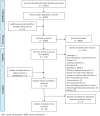Devices Used to Measure Force-Time Characteristics of Spinal Manipulations and Mobilizations: A Mixed-Methods Scoping Review on Metrologic Properties and Factors Influencing Use
- PMID: 35295511
- PMCID: PMC8915691
- DOI: 10.3389/fpain.2021.755877
Devices Used to Measure Force-Time Characteristics of Spinal Manipulations and Mobilizations: A Mixed-Methods Scoping Review on Metrologic Properties and Factors Influencing Use
Abstract
Background: Spinal manipulations (SMT) and mobilizations (MOB) are interventions commonly performed by many health care providers to manage musculoskeletal conditions. The clinical effects of these interventions are believed to be, at least in part, associated with their force-time characteristics. Numerous devices have been developed to measure the force-time characteristics of these modalities. The use of a device may be facilitated or limited by different factors such as its metrologic properties. Objectives: This mixed-method scoping review aimed to characterize the metrologic properties of devices used to measure SMT/MOB force-time characteristics and to determine which factors may facilitate or limit the use of such devices within the context of research, education and clinical practice. Methods: This study followed the Joanna Briggs Institute's framework. The literature search strategy included four concepts: (1) devices, (2) measurement of SMT or MOB force-time characteristics on humans, (3) factors facilitating or limiting the use of devices, and (4) metrologic properties. Two reviewers independently reviewed titles, abstracts and full articles to determine inclusion. To be included, studies had to report on a device metrologic property (e.g., reliability, accuracy) and/or discuss factors that may facilitate or limit the use of the device within the context of research, education or clinical practice. Metrologic properties were extracted per device. Limiting and facilitating factors were extracted and themes were identified. Results: From the 8,998 studies initially retrieved, 46 studies were finally included. Ten devices measuring SMT/MOB force-time characteristics at the clinician-patient interface and six measuring them at patient-table interfaces were identified. Between zero and eight metrologic properties were reported per device: measurement error (defined as validity, accuracy, fidelity, or calibration), reliability/repeatability, coupling/crosstalk effect, linearity/correlation, sensitivity, variability, drift, and calibration. From the results, five themes related to the facilitating and limiting factors were developed: user-friendliness and versatility, metrologic/intrinsic properties, cost and durability, technique application, and feedback. Conclusion: Various devices are available to measure SMT/MOB force-time characteristics. Metrologic properties were reported for most devices, but terminology standardization is lacking. The usefulness of a device in a particular context should be determined considering the metrologic properties as well as other potential facilitating and limiting factors.
Keywords: facilitating factors; force-time characteristics; limiting factors; metrologic properties; mixed-methods; scoping review; spinal manipulation; spinal mobilization.
Copyright © 2021 Mercier, Rousseau, Funabashi, Descarreaux and Pagé.
Conflict of interest statement
The authors declare that the research was conducted in the absence of any commercial or financial relationships that could be construed as a potential conflict of interest.
Figures



Similar articles
-
Assessing forces during spinal manipulation and mobilization: factors influencing the difference between forces at the patient-table and clinician-patient interfaces.Chiropr Man Therap. 2020 Nov 10;28(1):57. doi: 10.1186/s12998-020-00346-1. Chiropr Man Therap. 2020. PMID: 33168008 Free PMC article.
-
Beyond the black stump: rapid reviews of health research issues affecting regional, rural and remote Australia.Med J Aust. 2020 Dec;213 Suppl 11:S3-S32.e1. doi: 10.5694/mja2.50881. Med J Aust. 2020. PMID: 33314144
-
Investigation of the factors influencing spinal manipulative therapy force transmission through the thorax: a cadaveric study.Chiropr Man Therap. 2023 Aug 7;31(1):24. doi: 10.1186/s12998-023-00493-1. Chiropr Man Therap. 2023. PMID: 37550682 Free PMC article.
-
Provider kinematic strategies during the delivery of spinal manipulation and mobilization: a scoping review of the literature.Chiropr Man Therap. 2025 Jan 6;33(1):1. doi: 10.1186/s12998-024-00564-x. Chiropr Man Therap. 2025. PMID: 39762951 Free PMC article.
-
Spinal manual therapy in infants, children and adolescents: A systematic review and meta-analysis on treatment indication, technique and outcomes.PLoS One. 2019 Jun 25;14(6):e0218940. doi: 10.1371/journal.pone.0218940. eCollection 2019. PLoS One. 2019. PMID: 31237917 Free PMC article.
Cited by
-
Spinal mobilization force-time characteristics: A scoping literature review.PLoS One. 2023 Nov 14;18(11):e0289462. doi: 10.1371/journal.pone.0289462. eCollection 2023. PLoS One. 2023. PMID: 37963125 Free PMC article.
-
Spinal manipulation characteristics: a scoping literature review of force-time characteristics.Chiropr Man Therap. 2023 Sep 13;31(1):36. doi: 10.1186/s12998-023-00512-1. Chiropr Man Therap. 2023. PMID: 37705030 Free PMC article.
-
The role of force-sensing devices in spinal manipulative therapy research, education, and clinical practice.J Can Chiropr Assoc. 2025 Apr;69(1):6-15. J Can Chiropr Assoc. 2025. PMID: 40511282 Free PMC article.
References
Publication types
LinkOut - more resources
Full Text Sources

